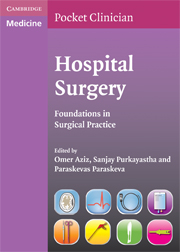Book contents
- Frontmatter
- Contents
- List of contributors
- Foreword by Professor Lord Ara Darzi KBE
- Preface
- Section 1 Perioperative care
- Section 2 Surgical emergencies
- Section 3 Surgical disease
- Hernias
- Dysphagia: gastro-oesophageal reflux disease (GORD)
- Dysphagia: oesophageal neoplasia
- Dysphagia: oesophageal dysmotility syndromes
- Gastric disease: peptic ulcer disease (PUD)
- Gastric disease: gastric neoplasia
- Hepatobiliary disease: jaundice
- Hepatobiliary disease: gallstones and biliary colic
- Hepatobiliary disease: pancreatic cancer
- Hepatobiliary disease: liver tumours
- The spleen
- Inflammatory bowel disease: Crohn's disease
- Inflammatory bowel disease: ulcerative colitis
- Inflammatory bowel disease: infective colitis
- Inflammatory bowel disease: non-infective colitis
- Colorectal disease: colorectal cancer
- Colorectal disease: colonic diverticular disease
- Perianal: haemorrhoids
- Perianal: anorectal abscesses and fistula in ano
- Perianal: pilonidal sinus and hidradenitis suppurativa
- Perianal: anal fissure
- Chronic limb ischaemia
- Abdominal aortic aneurysms
- Diabetic foot
- Carotid disease
- Raynaud's syndrome
- Varicose veins
- General aspects of breast disease
- Benign breast disease
- Breast cancer
- The thyroid gland
- Parathyroid
- Adrenal pathology
- Multiple endocrine neoplasia (MEN)
- Obstructive urological symptoms
- Testicular lumps and swellings
- Haematuria
- Brain tumours
- Hydrocephalus
- Spinal cord injury
- Superficial swellings and skin lesions
- Section 4 Surgical oncology
- Section 5 Practical procedures, investigations and operations
- Section 6 Radiology
- Section 7 Clinical examination
- Appendices
- Index
Obstructive urological symptoms
Published online by Cambridge University Press: 06 July 2010
- Frontmatter
- Contents
- List of contributors
- Foreword by Professor Lord Ara Darzi KBE
- Preface
- Section 1 Perioperative care
- Section 2 Surgical emergencies
- Section 3 Surgical disease
- Hernias
- Dysphagia: gastro-oesophageal reflux disease (GORD)
- Dysphagia: oesophageal neoplasia
- Dysphagia: oesophageal dysmotility syndromes
- Gastric disease: peptic ulcer disease (PUD)
- Gastric disease: gastric neoplasia
- Hepatobiliary disease: jaundice
- Hepatobiliary disease: gallstones and biliary colic
- Hepatobiliary disease: pancreatic cancer
- Hepatobiliary disease: liver tumours
- The spleen
- Inflammatory bowel disease: Crohn's disease
- Inflammatory bowel disease: ulcerative colitis
- Inflammatory bowel disease: infective colitis
- Inflammatory bowel disease: non-infective colitis
- Colorectal disease: colorectal cancer
- Colorectal disease: colonic diverticular disease
- Perianal: haemorrhoids
- Perianal: anorectal abscesses and fistula in ano
- Perianal: pilonidal sinus and hidradenitis suppurativa
- Perianal: anal fissure
- Chronic limb ischaemia
- Abdominal aortic aneurysms
- Diabetic foot
- Carotid disease
- Raynaud's syndrome
- Varicose veins
- General aspects of breast disease
- Benign breast disease
- Breast cancer
- The thyroid gland
- Parathyroid
- Adrenal pathology
- Multiple endocrine neoplasia (MEN)
- Obstructive urological symptoms
- Testicular lumps and swellings
- Haematuria
- Brain tumours
- Hydrocephalus
- Spinal cord injury
- Superficial swellings and skin lesions
- Section 4 Surgical oncology
- Section 5 Practical procedures, investigations and operations
- Section 6 Radiology
- Section 7 Clinical examination
- Appendices
- Index
Summary
Introduction
Obstructive urinary symptoms result from mechanical obstruction to the flow of urine at time of micturition. The level of obstruction can be anywhere from the bladder neck to the external urethral meatus. The term bladder outflow obstruction (BOO) is often used to describe the constellation of symptoms that results. Sometimes urologists will elect to use the term ‘lower urinary tract symptoms ’ (LUTS) if the patient's symptoms are both obstructive and storage (irritative) in nature.
Definition and classification
▪ Obstructive symptoms include: hesitancy, straining, decreased force of urination, intermittent stream, prolonged micturition, post-micturition dribbling and a sensation of incomplete bladder emptying.
▪ Objective measurements include use of basic urodynamic flow studies and completion of validated symptom score e.g. I-PSS (international prostate symptom score).
▪ It is important to distinguish these from storage symptoms, which include frequency, nocturia, urgency and dysuria. Although storage symptoms may result from bladder outlet obstruction, their presence should prompt investigation for a more sinister cause, e.g. carcinoma in situ of the bladder.
Incidence
Obstructive urinary symptoms are far more common in men by virtue of benign prostatic hyperplasia (BPH). Incidence and therefore prevalence is difficult to determine, as there is no standardized definition for BPH. Histologically this is not found in males under 30 years old but is found in 88% of 90-year-old men.
Aetiology
The most common causes include:
▪ BPH
▪ Urethral strictures.
Other causes include:
▪ Bladder neck hypertrophy
▪ Marked prostatitis
▪ Urethral calculi
▪ Urethral meatal stenosis
▪ Phimosis
▪ Neurogenic detrusor/sphincter dysfunction.
- Type
- Chapter
- Information
- Hospital SurgeryFoundations in Surgical Practice, pp. 522 - 526Publisher: Cambridge University PressPrint publication year: 2009

